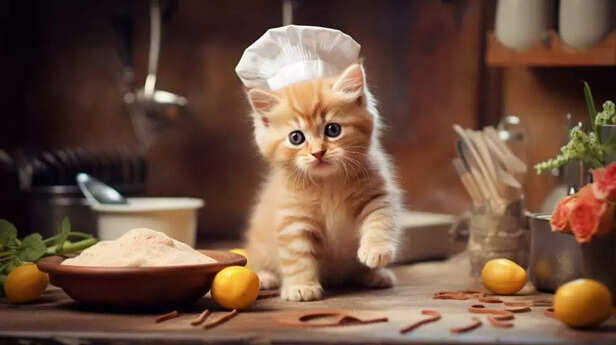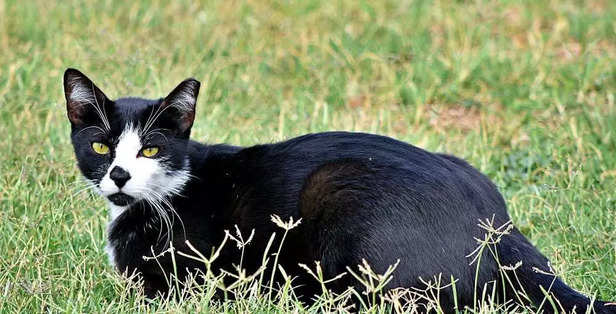Why Were Cats So Sacred in Ancient Egypt?
Pallavi Thakur | Mar 25, 2025, 10:58 IST
Why were cats so secrets in Ancient Egypt
Discover the rich history of cat domestication, from their sacred status in ancient Egypt to their role as beloved pets today.
The African wildcat was first tamed in ancient Egypt some 4,000 years ago, marking the beginning of cat domestication. Cats were domesticated for their mystical importance and pest-controlling abilities, in contrast to other domesticated animals like cattle or sheep that directly aid in human existence. Because the goddess Bastet was portrayed as a woman with a feline head, the ancient Egyptians associated cats with being heavenly. As the guardian of houses, fertility, and childbirth, Bastet was held in high regard. Many cats were mummified and buried alongside their owners because Egyptians valued cats so highly that hurting one was a grave sin.
For many years, it was thought that cats were initially domesticated by the Egyptians some 3,600 years ago. But according to new research, domestication may have begun even earlier when humans and cats grew to be mutually beneficial, with humans providing a steady supply of food and cats controlling rodent populations. Domesticated cats gradually made their way from Egypt to other countries, eventually developing into the wide variety of varieties that we are familiar with today.

Every cat breed has unique traits, ranging from personalities to physical attributes. Here are a few of the most well-liked breeds:
Well-known for their long, opulent coats and peaceful, submissive disposition, Persians are great indoor pets. They are popular among cat lovers because of their kind disposition.
Distinguished by their vivid blue eyes and points on their coats, Siamese cats are gregarious, intelligent, and talkative, frequently having "conversations" with their owners.
Known for their gregarious and extroverted nature, Maine Coons are the largest breed of domestic cats. They are recognizable by their long, bushy tails, tufted ears, and ruffs around their necks.
Bengals are very active and intelligent animals that resemble wild leopards. They need a lot of playtime and mental stimulation.

Whether they are strays, pets, or wild animals, cats are incredibly adaptive animals that flourish in a variety of settings.
: Whether in apartments or homes with yards, a lot of cats reside in human homes. They take pleasure in regular care, organized meals, and company.
: Found in rural, suburban, and urban settings, stray cats are not owned by anybody and frequently rely on food given by people.
are those that survive and procreate in the wild without assistance from humans. They stay away from people and hunt and scavenge for food.
:These comprise species that are suited to savannahs, open woodlands, scrublands, marshes, and farming, such as the Asiatic and African wildcats. 
There are many different kinds of cats in India, including both domestic and foreign breeds. The Indian Shorthair breed is especially hardy and adapts well to the climate of the nation. Cats' versatility has allowed them to blend in with Indian homes, where they are used as effective pest controllers and companions.
Cats have a unique place in human history, from their revered standing in ancient Egypt to their status as cherished pets in contemporary homes. They remain one of the most beloved creatures in the world because of their intellect, adaptability, and loving disposition. Cats have been admired and loved for ages because of their enigmatic and independent personality, whether they are living in an apartment in the city or wandering the outdoors.
For many years, it was thought that cats were initially domesticated by the Egyptians some 3,600 years ago. But according to new research, domestication may have begun even earlier when humans and cats grew to be mutually beneficial, with humans providing a steady supply of food and cats controlling rodent populations. Domesticated cats gradually made their way from Egypt to other countries, eventually developing into the wide variety of varieties that we are familiar with today.
The Characteristics of Well-Known Cat Breed

cat breed
Every cat breed has unique traits, ranging from personalities to physical attributes. Here are a few of the most well-liked breeds:
Persian
Siamese
Maine Coon
Bengal
Cat Habitats and Adaptations

cats habitates and adaptation
Whether they are strays, pets, or wild animals, cats are incredibly adaptive animals that flourish in a variety of settings.
Domestic Pets
Stray Cats
Feral cats
Wild cats
The Indian Subcontinent's felines

The Indian Subcontinence
There are many different kinds of cats in India, including both domestic and foreign breeds. The Indian Shorthair breed is especially hardy and adapts well to the climate of the nation. Cats' versatility has allowed them to blend in with Indian homes, where they are used as effective pest controllers and companions.
Cats have a unique place in human history, from their revered standing in ancient Egypt to their status as cherished pets in contemporary homes. They remain one of the most beloved creatures in the world because of their intellect, adaptability, and loving disposition. Cats have been admired and loved for ages because of their enigmatic and independent personality, whether they are living in an apartment in the city or wandering the outdoors.
